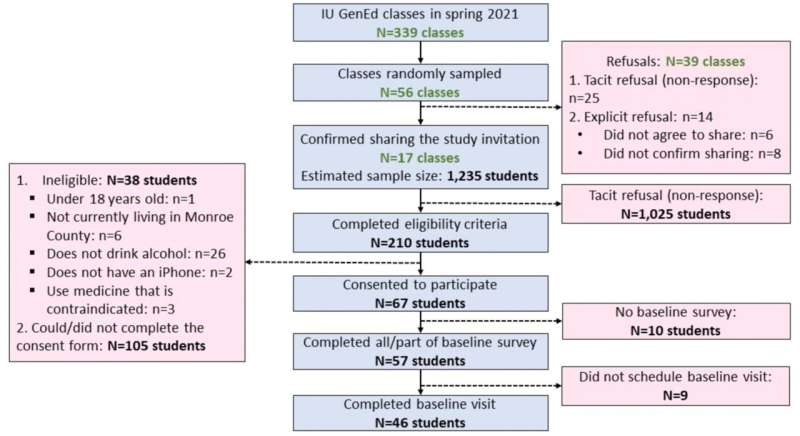This article has been reviewed according to Science X's editorial process and policies. Editors have highlighted the following attributes while ensuring the content's credibility:
fact-checked
peer-reviewed publication
trusted source
proofread
First open-source model for transdermal alcohol content detection

Indiana University's Sina Kianersi, a recent School of Public Health-Bloomington doctoral candidate, has developed the first open-source model to translate transdermal alcohol content—data collected from skin secretions—into information that can be used by researchers.
The monitors can help researchers studying alcohol use and the development of chronic disease.
Kianersi, now a post-doctoral fellow at Harvard University, used machine learning and signal filtering to create a successful model to read the transdermal alcohol content. The results were published in Addiction.
The transdermal alcohol content data in the study were collected via BACtrack Skyn, an alcohol biosensor worn on the wrist like a fitness activity tracker. The sensor collects alcohol data secreted through the skin—about one percent of alcohol consumed—every 20 seconds. Kianersi's model transcribes the data into information about how much alcohol was consumed and at what time.
"The next step for the algorithm is for other researchers to test the model in different populations," Kianersi said. "This is the first time an algorithm for transdermal alcohol content has been validated and published publicly for other researchers to use the model in their own research."
To obtain comparison data to develop the model, study participants manually tracked their alcohol usage, answered daily survey questions about their alcohol use in the past 24 hours and some used keychain breathalyzers tracking their blood alcohol content.
The main use of the model will be a new generation of wearable alcohol monitors. Researchers can better understand the effects of different amount and patterns of alcohol use and the development of chronic diseases, such as diabetes or cancer. Other uses would be a role in social and family monitoring of alcohol use or public health campaigns to promote responsible alcohol use within communities.
Jon Agley, deputy director of research at Prevention Insights, associate professor of Applied Health Sciences and co-author of the study got involved when Kianersi won IU's Prevention Insights' Big Idea Challenge in 2020.
"Our center sought out potentially transformative student ideas, and Sina's proposal quickly rose to the top," Agley said.
"This publication makes a significant impact in the field of alcohol research and is the culmination of Sina's hard work and academic accomplishments," Rosenberg said. "It is also a good example of the kind of stellar work that can get done at IU with capable student leadership, multidisciplinary faculty mentorship and strategic university investment. We're so proud of Sina."
More information: Sina Kianersi et al, Development and validation of a model for measuring alcohol consumption from transdermal alcohol content data among college students, Addiction (2023). DOI: 10.1111/add.16228



















